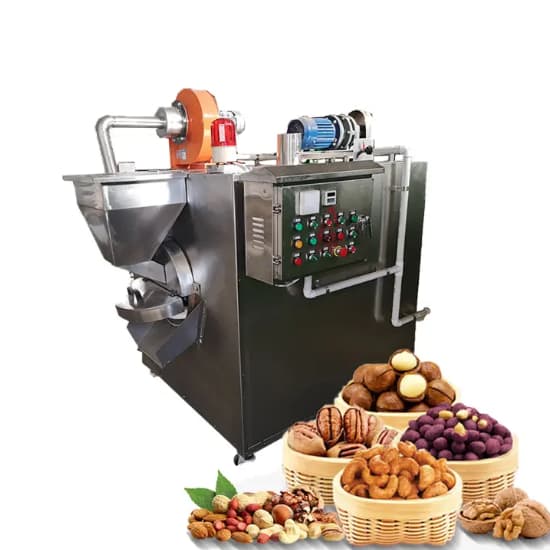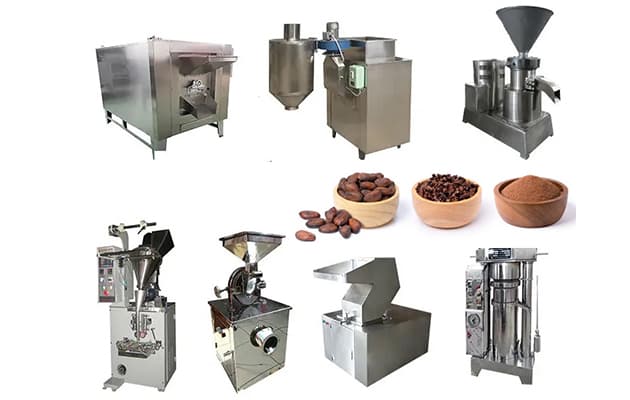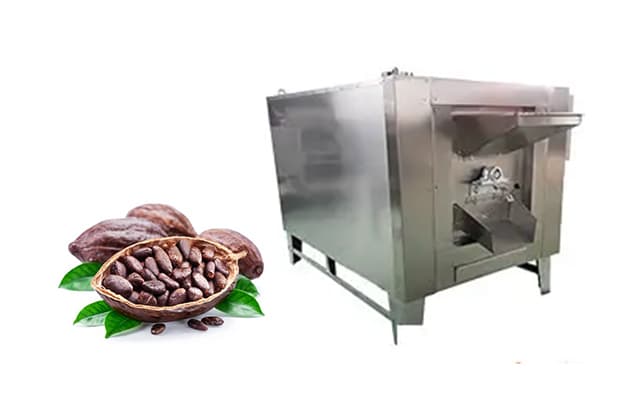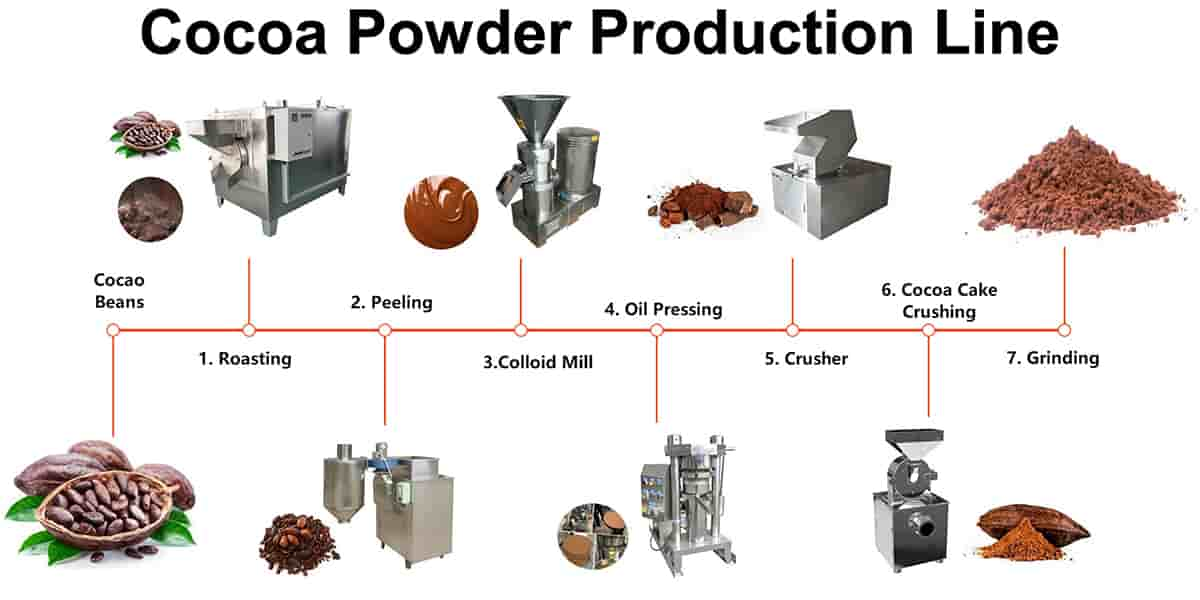Introduction to Industrial Cocoa Roasters
Industrial cocoa roasters are specialized machines used in large-scale chocolate manufacturing to roast raw cocoa beans. Roasting is a vital step in developing the rich, deep flavor associated with premium chocolate. This guide explores various types of cocoa bean roasting machines, aplikasi mereka, and how to select the ideal equipment for your production needs.

Why Cocoa Roasting Is Crucial in Chocolate Production
Cocoa roasting transforms the chemical composition of cocoa beans, enhancing their flavor, aroma, and color. Unroasted beans have a bitter, earthy taste and must undergo controlled heat exposure to unlock their true chocolatey potential.
Flavor Development Through Roasting
During roasting, Maillard reactions and caramelization produce hundreds of volatile compounds that contribute to the chocolate’s complex flavor profile.
Microbial Reduction and Shell Removal
Roasting also reduces microbial contamination and loosens the bean shell, making it easier to winnow during post-roast processing.
Types of Industrial Cocoa Roasting Machines
Several types of commercial cocoa roasters are available, each with specific features suited for different production scales and roasting preferences.
1. Drum-Type Cocoa Bean Roaster
Drum roasters rotate cocoa beans inside a cylindrical drum exposed to external heating elements.
- Long-Tail Keyword: rotary drum cocoa roaster
- Aplikasi: Medium to large factories
- Pro: Even roasting, energy efficient
- Kontra: Slightly longer roasting times
2. Hot Air Roaster
Hot air roasters use convection heat to roast beans suspended in a stream of hot air.
- Long-Tail Keyword: fluidized bed cocoa roasting machine
- Aplikasi: High-volume, high-speed operations
- Pro: Faster roasting, minimal burning
- Kontra: Higher initial cost
3. Infrared Cocoa Roaster
Infrared roasters use radiation heating to roast beans more precisely and gently.
- Long-Tail Keyword: infrared cocoa roasting technology
- Aplikasi: Specialty or small-batch chocolate makers
- Pro: Enhanced flavor control, energy savings
- Kontra: Lower throughput

Key Features of a Commercial Cocoa Roaster
Choosing the best industrial cocoa roaster means understanding what features truly matter in production.
1. Capacity and Throughput
Roasters range from 5 kg to 2,000 kg per batch. Your machine size should match your daily processing requirements.
2. Temperature Control System
Precision temperature control ensures consistent flavor and reduces the risk of burning or under-roasting.
3. Uniform Bean Mixing
Efficient agitation or air circulation guarantees uniform exposure to heat.
4. Kualitas material
Stainless steel bodywork is essential for food-grade hygiene and longevity.
5. Automation and Programmability
Modern cocoa bean roasters often feature digital panels, programmable profiles, and remote monitoring.
Cocoa Roasting Process in Industrial Settings
Understanding the roasting workflow helps optimize both flavor and efficiency.
1. Preheating the Roaster
The roasting chamber is preheated to the desired temperature, typically between 120°C to 160°C.
2. Loading and Roasting
Beans are loaded and roasted while temperature and time are precisely monitored. Roasting times vary between 15–45 minutes depending on the bean type and desired profile.
3. Pendinginan
Setelah dipanggang, beans are quickly cooled in a separate cooling tray to stop further roasting and preserve the desired flavors.

Comparing Small-Scale vs. Large-Scale Cocoa Roasting Equipment
| Fitur | Small-Scale Roasters | Large-Scale Roasters |
|---|---|---|
| Kapasitas | 5–50 kg/batch | 100–2,000 kg/batch |
| Otomatisasi | Setengah otomatis | Fully automatic with PLC control |
| Metode Pemanasan | Electric or gas | Gas, hot air, or hybrid |
| Target Users | Artisan chocolatiers | Industrial chocolate factories |
| Kisaran Biaya | $5,000 - - $25,000 | $50,000 - - $300,000+ |
How to Choose the Best Industrial Cocoa Roaster
Nilai Volume Produksi Anda
Choose a machine that can handle your current capacity with room for growth.
Consider Energy Efficiency
Look for energy-saving systems like heat recovery or infrared heating.
Examine the Roasting Profile Customization
Ensure the machine can store and replicate roasting profiles for product consistency.
Vendor Reputation and After-Sales Support
Work with suppliers who offer training, dukungan teknis, dan ketersediaan suku cadang.

Top Manufacturers of Industrial Cocoa Roasters
Some leading manufacturers of cocoa roasting equipment include:
- Bühler Group (Switzerland) – Known for scalable, automated roasting systems.
- JAF Inox / Royal Duyvis Wiener (Belanda) – Specialty machines for fine chocolate.
- Selmi (Italia) – Artisan and semi-industrial roasters.
- GSR Cocoa Machinery (Italia) – Customizable roasters with advanced heat control.
- Cacao Cucina (Amerika Serikat) – Popular among craft chocolate producers.
Industrial Cocoa Roaster Maintenance Tips
Maintaining your cocoa roaster is critical to ensuring long-term performance.
Routine Cleaning
Clean chaff collectors, drums, and filters regularly to prevent blockages and contamination.
Inspection of Heating Elements
Check for wear or corrosion in gas burners or electric coils.
Software and Sensor Calibration
Ensure temperature probes and PLC systems remain accurate over time.
Kesimpulan: The Heart of Chocolate Flavor
An industrial cocoa roaster is more than just a machine—it’s the heart of the chocolate-making process. Whether you are launching a bean-to-bar chocolate factory or scaling up your production, investing in the right cocoa roasting system ensures consistent quality, efisiensi, and flavor that customers will love.
